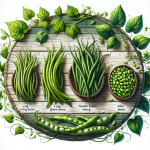Types Of Pasta
Pasta is a staple food in many households and has been enjoyed for centuries. With so many different types of pasta available, it can be overwhelming to choose the right one for a specific dish. Understanding the different types of pasta, their unique shapes, and how they are best used can help elevate any pasta dish to the next level.
Pasta Fundamentals:
Pasta is a traditional Italian dish made from a mixture of flour, eggs, and water. There are two main types of pasta: fresh and dried. Fresh pasta is made from scratch and is typically used in dishes like lasagna or ravioli. Dried pasta is more commonly used and is available in a variety of shapes and sizes.
Popular Pasta Varieties:
There are countless varieties of pasta available, each with its own unique shape and texture. Some popular pasta varieties include spaghetti, fettuccine, penne, and linguine. Each variety is best suited for specific dishes and sauces.
Key Takeaways
- Understanding the different types of pasta and their unique shapes is key to elevating any pasta dish.
- Fresh and dried pasta are the two main types of pasta, with each having its own unique uses.
- Some popular pasta varieties include spaghetti, fettuccine, penne, and linguine, each best suited for specific dishes and sauces.
Pasta Fundamentals

When it comes to pasta, there are countless types, shapes, and sizes to choose from. Understanding the basics of pasta types by shape and by ingredient can help you choose the perfect pasta for your dish.
Pasta Types by Shape
Pasta is typically categorized by its shape, which can affect its texture, cooking time, and sauce pairing. Some popular pasta shapes include:
- Spaghetti: Long, thin noodles that are perfect for pairing with tomato-based sauces or oil-based sauces.
- Penne: Short, tube-shaped pasta with ridges that are ideal for holding onto thicker sauces.
- Fusilli: Spiral-shaped pasta that goes well with both creamy and tomato-based sauces.
- Linguine: Similar to spaghetti, but slightly wider and flatter. It pairs well with seafood and lighter sauces.
- Lasagna: Flat, wide noodles that are perfect for layering in baked pasta dishes.
Pasta Types by Ingredient
Pasta can also be categorized by its ingredients, which can affect its nutritional value and taste. Some popular pasta types by ingredient include:
- Egg Noodles: Made with egg and wheat flour, these noodles have a rich flavor and a smooth texture.
- Fresh Pasta: Made with eggs and flour, fresh pasta has a delicate texture and a shorter cooking time than dried pasta.
- Dried Pasta: Made with durum wheat flour and water, dried pasta has a longer shelf life and a firmer texture than fresh pasta.
- Whole Wheat Pasta: Made with whole wheat flour, this type of pasta is higher in fiber and nutrients than traditional pasta.
- Gluten-Free Pasta: Made with alternative flours such as rice or corn, gluten-free pasta is a great option for those with gluten sensitivities.
Understanding the basics of pasta types by shape and by ingredient can help you choose the perfect pasta for your dish. Whether you prefer spaghetti with a classic tomato sauce or lasagna layered with cheese and meat, there is a pasta shape and type to suit every taste and preference.
Popular Pasta Varieties
When it comes to pasta, there are a lot of different varieties to choose from. In this section, we’ll take a look at some of the most popular types of pasta, organized by shape and size.
Long and Thin Pasta
Long and thin pasta varieties are great for dishes with lighter sauces or for adding to soups. Spaghetti and angel hair are two of the most well-known types of long and thin pasta. Spaghetti is a classic pasta shape that works well with a variety of sauces, while angel hair is a delicate pasta that is best served with light or creamy sauces.
Another popular long and thin pasta is fettuccine. This pasta is wider than spaghetti and is often used in dishes with richer sauces, like Alfredo sauce.
Short and Tubular Pasta
Short and tubular pasta varieties are great for dishes with thicker sauces or for adding to salads. Penne, macaroni, ziti, and rigatoni are all popular types of short and tubular pasta.
Penne is a versatile pasta shape that works well in a variety of dishes. It has a cylindrical shape with angled ends, making it perfect for holding onto sauces. Macaroni is a classic pasta shape that is often used in dishes like macaroni and cheese. Ziti is a tube-shaped pasta that is often used in baked pasta dishes, while rigatoni is a wider tube-shaped pasta that is great for holding onto chunky sauces.
Soup Pasta
Soup pasta is a smaller pasta shape that is often used in soups and stews. Orzo and ditalini are two popular types of soup pasta.
Orzo is a small, rice-shaped pasta that is often used in soups and salads. Ditalini is a small, tube-shaped pasta that is great for adding to soups and stews.
Stuffed Pasta
Stuffed pasta is a type of pasta that is filled with a variety of ingredients, like cheese, meat, or vegetables. Ravioli and tortellini are two popular types of stuffed pasta.
Ravioli is a square-shaped pasta that is filled with cheese, meat, or vegetables. Tortellini is a ring-shaped pasta that is also filled with cheese, meat, or vegetables. Both ravioli and tortellini are great for adding to soups or for serving with a simple sauce.
Cooking and Preparation
Boiling Pasta
Cooking pasta is a simple process that requires only a few basic steps. The first step is to bring a large pot of water to a rolling boil. It’s important to use a large pot of water to ensure that the pasta has enough room to cook and doesn’t stick together. A general rule of thumb is to use six quarts of water for every pound of pasta.
Once the water is boiling, add salt to the water. Salt helps to flavor the pasta and also helps to prevent the pasta from sticking together. A good rule of thumb is to add one tablespoon of salt for every six quarts of water.
Next, add the pasta to the boiling water and stir occasionally to prevent the pasta from sticking together. Cook the pasta until it is al dente, which means it is cooked but still firm to the bite. The cooking time will vary depending on the type of pasta and the brand, so it’s important to check the package instructions for the recommended cooking time.
When the pasta is cooked, drain it in a colander and rinse it with cold water to stop the cooking process. The pasta is now ready to be used in your favorite recipe.
Baking Pasta
Baking pasta is a popular way to prepare dishes like casseroles and lasagna. To bake pasta, start by cooking the pasta until it is al dente. Drain the pasta and rinse it with cold water to stop the cooking process.
Next, prepare the sauce and any other ingredients that will be used in the dish. Layer the pasta, sauce, and any other ingredients in a baking dish, making sure to coat the pasta evenly with the sauce.
Cover the dish with foil and bake in a preheated oven according to the recipe instructions. Remove the foil during the last few minutes of baking to allow the top to brown and become crispy.
Baked pasta dishes are a great way to feed a crowd and can be prepared ahead of time and reheated later. They also allow for a variety of textures and flavors to be incorporated into the dish, making them a versatile and delicious option for any occasion.
Pasta Dishes and Recipes
When it comes to pasta dishes, there are countless options available. From classic recipes that have been enjoyed for generations to innovative creations that push the boundaries of traditional cuisine, there is something for everyone. In this section, we will explore some of the most popular pasta dishes and recipes, including both traditional and modern favorites.
Classic Pasta Recipes
Classic pasta recipes are timeless dishes that have been enjoyed for generations. These recipes often feature simple ingredients, such as tomato sauce, meat sauces, cream, butter, and cheese, that come together to create a delicious and satisfying meal. Some of the most popular classic pasta recipes include:
-
Spaghetti with tomato sauce: This classic dish features spaghetti noodles topped with a simple tomato sauce made from canned tomatoes, garlic, and olive oil. It is a quick and easy meal that can be made in just 30 minutes.
-
Mac and cheese: This classic comfort food features elbow macaroni noodles coated in a creamy cheese sauce made from butter, milk, and cheddar cheese. It is a favorite of both kids and adults alike.
-
Minestrone: This hearty soup features a variety of vegetables, beans, and pasta in a flavorful tomato broth. It is a great way to use up leftover vegetables and makes for a healthy and satisfying meal.
Innovative Pasta Creations
Innovative pasta creations are modern twists on traditional pasta dishes that incorporate new ingredients and flavor combinations. These recipes often feature unique sauces, such as pesto or sage butter, and unusual pasta shapes, such as fusilli or farfalle. Some of the most popular innovative pasta creations include:
-
Pesto pasta salad: This refreshing salad features fusilli noodles tossed with a homemade pesto sauce made from basil, garlic, and pine nuts. It is a great dish for summer picnics and barbecues.
-
Meatball pasta bake: This hearty casserole features penne noodles topped with homemade meatballs and a rich tomato sauce. It is a great dish for feeding a crowd and can be made ahead of time for easy entertaining.
-
Garlic sage butter pasta: This simple yet flavorful dish features linguine noodles tossed with a buttery sauce made from garlic and fresh sage. It is a great way to elevate a simple pasta dish and is perfect for a cozy night in.
In conclusion, pasta dishes are a versatile and delicious option for any meal. Whether you prefer classic recipes or innovative creations, there is a pasta dish out there for everyone. With a few simple ingredients and a little creativity, you can create a satisfying and flavorful meal that will be enjoyed by all.
Pairing Pasta with Sauces and Ingredients
When it comes to pairing pasta with sauces, there are a few things to keep in mind. Certain pasta shapes work better with certain sauces, and different ingredients can enhance the flavor of the dish. Here are some tips for pairing pasta with sauces and ingredients.
Sauces for Pasta
There are many different types of sauces that can be paired with pasta. Some of the most popular include:
-
Tomato sauce: A classic choice for pasta, tomato sauce goes well with a variety of pasta shapes. It can be made with fresh or canned tomatoes, and can be seasoned with herbs like basil, oregano, and thyme.
-
Cream sauce: Creamy sauces like Alfredo are a great choice for pasta dishes. They pair well with long, flat pasta shapes like fettuccine or linguine.
-
Pesto: Made with fresh basil, garlic, and pine nuts, pesto is a flavorful sauce that goes well with short pasta shapes like penne or fusilli.
-
Oil-based sauces: Oil-based sauces like aglio e olio are simple but delicious. They’re perfect for long pasta shapes like spaghetti or linguine.
Vegetable and Meat Pairings
In addition to sauces, vegetables and meats can also be paired with pasta to create delicious dishes. Here are some popular pairings:
-
Vegetables: Vegetables like broccoli, spinach, and mushrooms are great additions to pasta dishes. They can be sautéed or roasted and added to the pasta along with the sauce.
-
Meat: Meats like chicken, beef, and sausage can be added to pasta dishes to make them heartier. They can be cooked separately and added to the pasta, or cooked with the sauce for added flavor.
-
Seafood: Seafood like shrimp, clams, and mussels can also be paired with pasta. They can be added to tomato-based or cream-based sauces for a delicious seafood pasta dish.
-
Cheese: Cheese like Parmesan and Ricotta can be added to pasta dishes for added flavor and creaminess. They can be sprinkled on top of the dish or mixed into the sauce.
In conclusion, pairing pasta with sauces and ingredients is all about finding the right combination of flavors and textures. By following these tips, you can create delicious pasta dishes that will satisfy any appetite.






